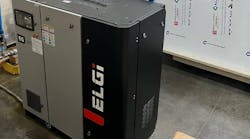Although cabinet cooling systems are robust and reliable, their efficacy depends upon their correct design, selection, and installation. It's essential that cooling solutions are properly sized to the heat load and that environmental considerations are taken into account. Unfortunately, this is not always the case, especially when equipment is replaced or upgraded by personnel with limited enclosure cooling expertise.
Here are seven common mistakes that we come across.
Fail #1: Oversized Air Conditioner
When you want to overcome enclosure overheating problems, the most logical solution is to go big and conquer enclosure overheating once and for all. While this technique of solving engineering problems usually works, it is not the right solution for air conditioning. An oversized cabinet air conditioner brings the temperature down too quickly, which means the duty cycle will be too low for effective humidity control, or the compressor will cycle frequently, and the temperature of the enclosure will swing excessively.
Fail #2: Fitting Air Conditioner to a Ventilated Enclosure
When cabinet ventilation is inadequate and unable to maintain the enclosure temperature at a reasonable level, the best solution is to install an enclosure air conditioner. However, it is essential that the cabinet's ventilation openings are sealed or hot air will enter the enclosure. This air leakage will cause the air conditioning compressor to run for long periods of time, causing rapid wear, and, in hot weather, it's unlikely the enclosure temperature will be properly controlled.
Fail #3: Leaving Enclosure Doors Open
It is not unusual for doors of electrical enclosures to be left open, especially when barriers are fitted preventing access to live parts and these enclosures are inside plant areas. However, this exposes the equipment to dust, debris and humidity, and poorly controlled temperatures. If the enclosure has an air conditioner, the air conditioner should be turned off or a door interlock switch should be fitted to de-energize the air conditioner while the doors are open to stop the compressor from running continuously.
Fail #4: Incorrect NEMA Enclosure Rating
The NEMA rating of an enclosure determines the degree of enclosure protection, with particular regard to protection against water, rain, dirt, and dust. For this reason, it is crucial that air conditioners conform to the same NEMA rating or else the NEMA rating of the electrical enclosure will be invalidated. This is particularly the case for outdoor enclosures and enclosures installed in harsh environments because the installation of an air conditioner with an inappropriate enclosure rating could lead to possible damage to the electrical equipment.
Find out more about Thermal Edge Inc. on the NED Directory.
Fail #5: Choosing the Cheapest Solution
A cabinet cooling system is sometimes regarded as a grudge purchase, and there's a temptation to skimp on costs. No one wants to pay more than is necessary, but be careful that you don't buy an enclosure air conditioner that is unsuitable for the application. Points to check are UL rating, thermal capacity at your operating temperature, condensate handling, power consumption, enclosure protection, robustness, spares, service, and support.
Fail #6: Fit and Forget
The most common reason for the failure of an air conditioner is the neglect of regular checks and preventive maintenance. Although Thermal Edge air conditioners are designed for unattended operation, it's essential to keep air filters clean and monitor performance. Blocked air filters increase compressor, condenser, and evaporator temperatures and may cause compressors to run continuously and overheat. Similarly, air leaks, open doors, and loose equipment placed in the wrong places may affect proper operation. If it's impractical to schedule regular maintenance inspections, then it's advisable to install remote monitoring equipment to raise an alarm if something goes wrong.
Fail #7: Upgrading Electrical Equipment and Not Reviewing Heat Load
This is possibly the most frequent cabinet cooling system problem. The capacity of the enclosure air conditioner must be correctly matched to the heat load, and when new equipment is added, the balance between heat load and cooling capacity may be upset. This issue is exacerbated because equipment upgrades often include the addition of variable speed drives and other electronic equipment controllers that generate a lot more heat than the equipment they replace. So, before adding equipment, do an Enclosure Thermal Management Calculation to establish if the air conditioner has adequate capacity.










